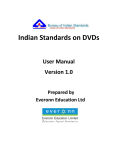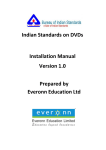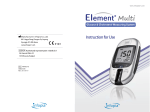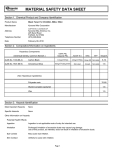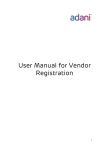Download GOVERNMENT OF INDIA MINISTRY OF RAILWAYS Issued
Transcript
Page 1 of 11 Issued on :xx/xx/2014 RDSO Spec No: RDSO/2014/EL/SPEC/xxxx (Rev 0) lR;eso t;rs GOVERNMENT OF INDIA MINISTRY OF RAILWAYS FUNCTIONAL REQUIREMENT SPECIFICATION FOR FUEL CELL SENSOR BASED BREATH ALCOHOL ANALYSER FOR GENERAL PURPOSE USE ON INDIAN RAILWAYS Spec No: RDSO/2014/EL/SPEC/xxxx (Rev 0), Issued on Nov ’2014 Approved by Signature Sr. EDSE/RDSO Issued by Electrical Directorate Research, Designs and Standards Organisation Manak Nagar, Lucknow-226011 Prepared by: SSE/SE&AM/RDSO ADE/SE&AM/RDSO Checked by: Issued by DSE/C&S/RDSO DSE/C&S/RDSO Page 2 of 11 Issued on :xx/xx/2014 RDSO Spec No: RDSO/2014/EL/SPEC/xxxx (Rev 0) Status of revision S.N. 1. 2. 3. 4. Date of Revision Page No. All Prepared by: SSE/SE&AM/RDSO ADE/SE&AM/RDSO Revision 0 Reasons for Revision First issue Checked by: Issued by DSE/C&S/RDSO DSE/C&S/RDSO Page 3 of 11 Issued on :xx/xx/2014 RDSO Spec No: RDSO/2014/EL/SPEC/xxxx (Rev 0) INDEX SN 1. 2. 3. 4. 5. 6. 7. 8. 9. 10. 11. 12. 13. 14. 15. ITEM PAGE NO. Preface Scope Terminology Construction Power Supply Requirements Technical Requirements Test Plan Quality Assurance Other Technical Requirement Marking Packing Manual Calibration System Evaluation Information to be supplied by the purchaser Prepared by: SSE/SE&AM/RDSO ADE/SE&AM/RDSO To be put on final specification. Checked by: Issued by DSE/C&S/RDSO DSE/C&S/RDSO Page 4 of 11 Issued on :xx/xx/2014 RDSO Spec No: RDSO/2014/EL/SPEC/xxxx (Rev 0) FUNCTIONAL REQUIREMENT SPECIFCATION FOR FUEL CELL SENSOR BASED BREATH ALCOHOL ANALYSER FOR GENERAL PURPOSE USE ON INDIAN RAILWAYS 1.0 1.1. Preface The earlier Spec No. RDSO/SPN/TR/290/BA (Rev.0)-2003 for Fuel Cell Sensor based Breath Alcohol Analyzer is superseded by this Spec No. RDSO/2014/EL/SPEC/xxxx (Rev 0), Nov’2014.This specification is prepared duly incorporating all the requirements with certain modifications owing to suggestions from Railways. 1.2. This specification requires reference to the following standards. IS: 9000 series: Basic environmental testing procedures for electronic and electrical items. 1.3. Wherever in this specification, any of the above mentioned specifications are referred to by number only without mentioning the year of issue, the latest issue of that specification is implied; otherwise the particular issue referred to is meant. 1.4. This specification is intended chiefly to cover the technical provisions and does not include all the necessary provisions of a contract. 2.0 2.1 Scope This specification covers the requirements for breath analyzer, which will detect the Blood Alcohol Concentration (BAC) by sampling breath of the person under observation. Breath to Blood alcohol ratio shall be 1:2100. 2.2 It shall be possible for the equipment to analyze the breath sample when subject takes deep breath inside and blows for a brief period through the disposable mouthpiece attached to the equipment. 3.0 3.1 Terminology ‘Routine tests’: - are those tests, which must be carried out on each equipment by the manufacturer. 3.2 ‘Acceptance test’: - are those tests which are particularly specified by the purchaser to be carried out on the equipment at various stages or on completion and may be any or all the tests concerned with the equipment before he accepts delivery. Prepared by: SSE/SE&AM ADE/SE&AM/RDSO Checked by: Issued by DSE/C&S/RDSO DSE/C&S/RDSO Page 5 of 11 Issued on :xx/xx/2014 RDSO Spec No: RDSO/2014/EL/SPEC/xxxx (Rev 0) 3.3 ‘Performance tests’: - are those tests which are required to prove satisfactory performance on an equipment under service conditions and shall include such of those tests as are required to investigate problems in its installation and maintenance. 4.0 4.1 Construction The equipment shall be wall mounted OR tabletop model OR hand held model as required by the purchaser. The standard and easily available switches, sockets, connectors and fuses shall be provided on the equipment. Fuses used shall be of glass/resettable type only. The equipment shall be supplied in a leather case or as specified by the purchaser with built-in RF shielding. It shall be dust proof, water resistant and robust in construction for rugged usage. All the electronic components used shall be of high reliability. Printed circuit boards shall be coated with transparent epoxy lacquer to provide environmental protection. No extra wires shall be used for inter-connection of components on the PC cards. Soldering of components shall be done meticulously so that joints are not dry. The name or trademark shall be engraved or indelibly printed on the cards. If more than one PCB is used, each shall be identified by a separate code to distinguish the cards. The cards shall be provided with testing points and the corresponding voltage shall be indicated in the fault diagnosis procedure in service manual to facilitate testing and fault finding. The equipment shall be so constructed as to prevent any possibility of tempering of readings by unauthorized access to the system. The surface of the equipment and housing shall be smooth, sound and free from moulding defects. All edges shall be neatly finished and free from splash. 4.2 4.3 4.4 4.5 4.6 4.7 4.8 4.9 5.0 5.1 5.2 5.3 5.4 5.5 Power Supply Requirements The power consumption of the system shall not be more than 5 watts without printer and 10 watts with printer. Equipment shall be capable of working on 230V AC as well as on DC. Maintenance free rechargeable Li ion battery with a capacity of 2000mAh or more which can meet the requirements shall be used for DC operation. The system shall work satisfactorily with input AC voltage variation from 160V to 280V AC without affecting the test results. Portable hand held type equipments may work on alkaline batteries. Two level of indication should be provided viz. One for warning for low battery indication and one for switching off. Under such a condition, no sample data shall be processed by the equipment. A built-in or as specified by the purchaser, battery charger cum adopter working on 230V AC ( Varying from 160V to 280V AC) shall be supplied along with the equipment. There shall be a protection from overcharge to improve battery life. Facility for “Auto Power Saving Mode” within 120 seconds when the equipment is inactive shall be provided. Prepared by: SSE/SE&AM ADE/SE&AM/RDSO Checked by: Issued by DSE/C&S/RDSO DSE/C&S/RDSO Page 6 of 11 Issued on :xx/xx/2014 RDSO Spec No: RDSO/2014/EL/SPEC/xxxx (Rev 0) 5.6 A suitable short circuit protection shall be provided for AC/DC operation. 6.0 6.1 Technical requirements The sensor used shall be of fuel cell type operating on electrochemical principles. The shelf life of fuel cell shall be minimum 3 years & shall be declared by the tenderer. The equipment shall be microprocessor based so as to provide optimum stability and accuracy. The entry shall be recorded through integrated alphanumeric key board. The parameter setting of equipment shall be password protected to avoid manipulation of test results.The entry filed & test results shall be bilingual i.e. Hindi & English The equipment shall be specific to alcohol and shall respond to only all primary and secondary aliphatic alcohol and in-sensitive to ketones, acetone, toluene or other substances that can be found in human breath. The measuring range of the equipment shall be up to 400 mg/100ml of Blood Alcohol Concentration (BAC) (Details of other units of measurement possible by the instrument shall be mentioned by the tenderer). The detection limit shall be 1 mg/100 ml of blood alcohol concentration. Equipment shall sound the buzzer OR the screen color shall change to RED whenever alcohol content crosses prescribed limit. Unit should detect and give alarm on wrong sampling. The accuracy of the equipment shall be ±5 % at 80mg/100ml of blood alcohol concentration. The operating temperature range of the equipment shall be from -10°C to 55°C with relative humidity reaching up to 95% at 40°C. The fuel cell should be automatic heated to permit accurate testing and rapid response even in low temperatures. One way flow round or square type mouthpieces shall only be used. Mouth piece used for sampling shall be able to filter out sputum and oral contaminants such as pan masala etc. so that it will not reach fuel cell and damage it, by virtue of its design. Mouth pieces shall be interchangeable for use with different make of breath analyzer. Calibration should be done with Wet gas simulator. A valid calibration certificate shall be issued by manufacturer at their premises. There shall be audio and visual indication for indicating ready for test, current status, change in instrument status and fault conditions. The breath sample shall be taken automatically through a subject blowing moderately and continuously for about 5 seconds in the mouthpiece. Automatic sampling shall ensure that deep lung air extracted through breath has been taken for testing. The sample is taken through a disposable mouthpiece into the sensor chamber. An override feature for manual sampling should also be provided. Manual sampling should be provided for passive mode. Each time the system is switched ‘ON’, it shall go through an automatic selfdiagnostic check. 6.2 6.3 6.4 6.5 6.6 6.7 6.8 6.9 6.10 6.11 6.12 Prepared by: SSE/SE&AM ADE/SE&AM/RDSO Checked by: Issued by DSE/C&S/RDSO DSE/C&S/RDSO Page 7 of 11 6.13 6.14 6.15 6.16 6.17 6.18 6.19 6.20 6.21 Issued on :xx/xx/2014 RDSO Spec No: RDSO/2014/EL/SPEC/xxxx (Rev 0) System shall automatically conduct a zero base line blank test to reset equipment to ensure that the sensor is clear of any contamination and ready for next operation without the need to power off. Warm-up on time (Power ON time) shall be less than 2 minutes and consecutive negative test time shall be less than 7 sec. Each test shall be given a test record Sr. No. to provide evidential security. This test record number shall be stored in the memory with the test result along with Crew ID, Head Quarter (HQ) name, Train number, Examiner’s ID, Alcohol Concentration, date & time, Calibration date etc. and shall appear on printout taken out for a test record. The equipment should not work in absence of crew ID but with a facility of dummy test without crew ID. It shall not be possible to cancel the positive test results. Memory full indication should appear sufficiently before full memory capacity utilization to enable to download the data or take out the print outs as the need be. Option should be available to either reset the memory and starting afresh with first serial number or memory automatically acting in a FIFO fashion i.e. first in first out basis. Equipment shall have memory capacity of storing minimum 10000 numbers of test data and results. Facility for recall of last test results shall always be available, even after auto power off/switching off & switching on again. The number of tests that can be conducted with fully charged battery shall be 1000 minimum. In case of portable equipment, if powered by alkaline batteries, minimum number of tests possible before need for replacement of batteries should be 1000 minimum also. Test result shall be displayed within 30 second after a sample is taken from the subject in case of negative sample (i.e. 0 mg/100ml BAC) & within 1 minute in case of positive sample (i.e. Equal or more than 1 mg/100ml BAC). LED/LCD backlit display shall be provided. Mode selection for time/date format shall be provided. It shall be possible to transfer readings to a personal computer/data logger for analysis. The facility for automatic transferring of data from equipment to Central Server viz.CMS(Crew Management System) through in built GPRS modem/ internet shall be provided. A built-in or otherwise 24 column width Dot Matrix printer/laser printer/inkjet printer/thermal with or without cordless principle for interfacing shall be provided in all wall mounted/table top models with following features: • • • • Working on plain paper roll and easily available ribbon cartridge. Print data should not fade away with time. Print out shall give details of date and time of blank & subject tests, test number, blank and subject test readings along with spaces for signatures and details of subject, operator and witness (or as customized as required by the purchaser). Printer shall have auto shut down facility after printing to save power. Prepared by: SSE/SE&AM ADE/SE&AM/RDSO Checked by: Issued by DSE/C&S/RDSO DSE/C&S/RDSO Page 8 of 11 6.22 6.23 Issued on :xx/xx/2014 RDSO Spec No: RDSO/2014/EL/SPEC/xxxx (Rev 0) Portable Breath Analyzers (hand held type) having inbuilt Dot Matrix printer shall have the facility to be connected with portable separate printer having similar features as above for taking out printouts of test data. Equipment shall be immune to radio frequency (RF) interference in line with IEC 61326. Weight – In case of portable type breath analysers, weight of hand held basic unit i.e. breath analyser set only should be less than 600 gms (with batteries) so that the same can be carried by inspectorial staff during ambush checks and surprise checks. The total weight of complete portable breath analyser system including printer, charger, adopter and carry case should not be more than 3.5 Kgs. 7.0 Test Plan 7.1 Routine Tests 7.1.1 The following shall comprise the routine tests and shall be conducted by the manufacturer on every equipment and the test results shall be submitted to the inspection authority as nominated by the purchaser. a) Visual inspection (Clause 7.2.3) b) Functional and performance test (Clause 5.0, 6.0, 7.2.4 & as per manufacturer manual). c) Verification of marking (Clause 10.0) d) Any other test may be carried out as considered necessary by manufacturer. 7.1.2 The supplier will submit routine test reports of all units at the time of supply. 7.2 Acceptance test: 7.2.1 Lot as per sampling plan given in clause 7.2.2 shall be inspected by the representative of purchaser. The following shall constitute acceptance test:a) Visual inspection (Clause 7.2.3 except clause 4.7) b) Functional and performance test (Clause 2.0, 4.0, 5.0, 6.0 & manufacturer manual) c) Verification of marking (Clause 10.0) d) Any other test considered necessary by the inspecting agency. 7.2.2 For acceptance test equipment shall be selected for testing randomly as per following sampling plan • Up to 5 sets - 100% • 6 to 10 sets - 60% (subject to minimum 6) • 11-25 sets - 40% (subject to minimum 8) • For more than 25 sets - 20% (subject to minimum of 12 sets) 7.2.3 Visual inspection: - The equipment shall be visually inspected to ensure compliance of the requirements of Clause 2.0, 4.0, 5.0, 6.0 & 11.0. 7.2.4 Functional and performance test The test shall be based on system design. The methodologies to be adopted for various tests shall be decided taking into account the system design/configuration and manufacturing manual. All provision of Clause 5.0 & 6.0 shall be verified. Prepared by: SSE/SE&AM ADE/SE&AM/RDSO Checked by: Issued by DSE/C&S/RDSO DSE/C&S/RDSO Page 9 of 11 Issued on :xx/xx/2014 RDSO Spec No: RDSO/2014/EL/SPEC/xxxx (Rev 0) 7.3 Climatic Severity Test: These tests shall be carried out at NABL/ILAC accredited/ approved labs once in 3 years OR if any design/BOM is changed. 7.3.1 Dry Heat Test This test shall be conducted as per IS: 9000 (Part-III, Section 3) for 16 hours at 55 ± 20C. The equipment shall be kept energized (DC or AC) during this test. On completion of the test, the equipment shall be removed from the chamber and visually inspected to see that no part is damaged or cracked. Performance test shall be done to verify normal working. 7.3.2 Damp Heat (Accelerated) Test – First Cycle This test shall be conducted as per IS: 9000 (Part V, Section 1) at 40±2oC and relative humidity 90-95% for 24 hours (one complete cycle). The device shall not be energized during this test. After removal from the test chamber, the device shall be wiped with a dry cloth to remove condensed water from the surface and the performance test shall be carried out to verify normal working. 7.3.3 Cold Test (After First Cycle of Damp Heat) This test shall be conducted as per IS: 9000 (Part-II, Section 3) for 2 hours at – 100C. The device shall be operated ten times at the end of the test, with an interval of one minute between successive operations of the device to see that the device is working satisfactorily and that there is no seizure. The device shall be visually inspected to see that no part is damaged or cracked. 8.0 8.1 8.2 Quality Assurance All materials and workmanship shall be of good quality. Since the quality of the equipment bears a direct relationship to manufacturing process and the environment under which it is manufactured, the manufacturer shall maintain strict quality assurance programme of adequate standard. The manufacturer shall submit the Quality Assurance Plan & Quality manual. 9.0 9.1 Other Technical requirement Tenderers shall ensure that the product offered meets the statutory requirements if any. In case of indigenous manufacturer, they shall have the facility to manufacture the product from the component level. They shall have facility to solder components to the PCB. They shall have facility for conformal coating for humidity sealing. RDSO/CLW officials shall verify the manufacturing and testing facility during visit for registration and inspection. The tenderer shall also declare the source of raw material used. 9.2 10.0 Marking The following information shall be legibly and indelibly marked on the equipment and housing case at a suitable place. Prepared by: SSE/SE&AM ADE/SE&AM/RDSO Checked by: Issued by DSE/C&S/RDSO DSE/C&S/RDSO Page 10 of 11 a) b) c) d) e) f) Issued on :xx/xx/2014 RDSO Spec No: RDSO/2014/EL/SPEC/xxxx (Rev 0) Name or trademark of the manufacturer. Serial number of the equipment. Specification number. Month and year of manufacture. Approximate gross weight. The legend “INDIAN RAILWAY PROPERTY”. 11.0 Packing The equipment shall be so packed as to permit convenient handling and to protect against loss or damage and ingress of moisture during transit and storage. As the portable equipment is to be carried outside also, packing arrangement should be such that instrument is duly protected from water, dust and normal shock/ vibration during handling/carriage/storage. Individually hygienically wrapped mouth pieces packed in perforated bags shall be provided. 12.0 Manual Each equipment shall be supplied along with a bilingual (Hindi & English) operating manual/instruction hand book which shall give detailed instructions on operation and maintenance with suitable diagnostic chart including DO’s and DONT’s instructions. 13.0 Calibration Manufacturer/Tenderer shall have in house facility to calibrate and check the instrument. Firm will make provision for service centre and availability of spares to calibrate the supplied equipment. Calibration be done every 6 month and breath analyzer shall be sent by Railways to manufacturer premises for calibration of out of warranty equipments. In case of warranty failure, firm shall be collecting the material from Rly premises. 14.0 System Evaluation To judge suitability and evaluate the system & it’s performances, following shall be required to be furnished by the manufacturer/authorized supplier before system is accepted by the purchaser for use on Indian Railways. (i) Item wise compliance/remarks to specification requirements. (ii) Design criterion and system feature. (iii) System manual including operating instructions, diagnostics, do & dont’s etc. (iv) List of consumables involved for operation of the equipment. (v) Step-by-step procedure for functional and performance test to verify the system specification/features. (vi) Documentary evidences in supports of system specification parameter and claimed performance indexes. (vii) Documents in support of adaptability of equipments in organization other than Railways and performance feedback. (viii) List of existing customers including Railways. Prepared by: SSE/SE&AM ADE/SE&AM/RDSO Checked by: Issued by DSE/C&S/RDSO DSE/C&S/RDSO Page 11 of 11 Issued on :xx/xx/2014 RDSO Spec No: RDSO/2014/EL/SPEC/xxxx (Rev 0) (ix) List of accessories supplied along with the equipment and optional accessories offered. (x) Detailed technical specification along with test results/evaluation reports from NABL/ILAC accredited laboratory. (xi) NABL /ILAC accredited Laboratory test results shall be made available to ensure satisfactory working of equipment under climatic severities as provided in the specification (clause 7.3). (xii) System once evaluated shall be valid for 3 years subject to no change in the design by the manufacturer. (xiii) Manufacturer shall arrange a live demonstration by competent representative in the user premises on Railway’s request. (xiv) An undertaking to assure maintenance support for 10 years minimum. 15.0 Information to be supplied by the purchaser a) Model : Wall mounted or tabletop or hand held type (Cl. 4.1) b) Type of cover : Leather case or otherwise (Cl. 4.3) c) Battery charger cum adopter : Built-in or separate. d) Printer : Built-in or otherwise. e) List of consumable items to be supplied f) List of optimal accessories to be supplied g) Any other test to be performed by manufacturer & inspecting agency h) Inspection: (i) Prototype inspection by RDSO (ii) Routine inspection by consignee or otherwise. ***** Prepared by: SSE/SE&AM ADE/SE&AM/RDSO Checked by: Issued by DSE/C&S/RDSO DSE/C&S/RDSO














